|
FAQs about Acroporid Coral Disease/Health,
Parasites, Pests 2
FAQs on Acroporid Disease:
Acroporid Disease 1,
Acroporid Disease 3, Acroporid Disease/Pests/Predators
4, Acroporid Health
5, Acroporid Health
6, Acroporid Health
7, Acroporid Hlth.
8, Acroporid
Hlth. 9, Acroporid Hlth. 10,
FAQs on Acroporid Disease by Category:
Diagnosing,
Environmental (Pollution/Poisoning, Lighting...),
Nutritional, Social (Allelopathy),
Trauma,
Pathogenic (Infectious, Parasitic, Viral)
Predatory/Pest
(see below), Treatments
FAQs on Pests of Acroporids:
Montipora Munching Nudibranchs,
Flatworms,
Red/Black "Bugs"
Acropora Munching Copepods,
Related Articles: Coral Pests and Disease; pests, predators,
diseases and conditions by Sara Mavinkurve, Acroporids, SPS
Corals,
FAQs on Stony Coral Disease by Type: Brown Jelly Disease, RTN,
|
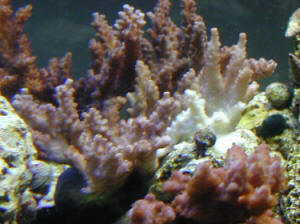
|
| White spots on Montipora 7/14/06
Hello, <Hi there> I have this
giant gorgeous piece of red, plating Montipora. About
a week ago I rearranged the live rock and moved the Montipora so
that it is higher in the tank, <By how much?> under
actinics but not directly under a metal
halide. Recently I noticed several white chalky spots
and streaks. They seem to be getting worse and
spreading. Our levels are fine <Numbers please...
vague generalities result in responses of the same quality>
and we've been feeing it DT's phyto and oyster
eggs. Our clowns hang out above it constantly but I
don't know if that has anything to do with
it. Please help me; I can't bare to loose <Or
lose?> this gorgeous piece!
Thanks, Krissi <... likely nothing
wrong here... a bit of reaction from the change in lighting...
Please read here: http://www.wetwebmedia.com/acropori.htm and the linked
files above. Bob Fenner, and the linked files above...> |
|
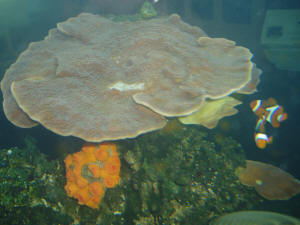
Re: White spots on Montipora, not reading
7/15/06 It was about 5 inches from the bottom of our tank and now
it is about 10 inches higher. <Likely about
doubled the effective photonic input> Nitrates,
Ammonia, Nitrites and Phosphates are at 0. dKH is 11
pH is 7.8 (can't keep it stably above that) <Do
read on WWM: http://www.wetwebmedia.com/marphalk.htm>
Salinity is 1.024 Temp is 79
Calcium is 425 Chelated Iron is .25
Iodine is .6 mg/l <Not continuously I
trust> I don't think it is a
reaction to the lighting change because the areas have not just
faded, they are chalky and completely white spots and streaks amongst
wonderfully healthy Montipora. I don't know,
though. It could be. I'm hoping that
it's not some kind of infection. Could it be caused by
bubbles trapped underneath them?
Thanks, Krissi <Not likely... It is almost
assuredly the light change... though could be a chemical burn from
supplements. Make such changes outside the system via new water...
and read. Bob Fenner>
|
Help for the reef on the
rocks 7/1/06 Dear crew: <Brad> I am
writing because I find myself once again in uncharted waters, and
my keel is grating along the rocks of ignorance as we
speak. <Heeee! Always a pleasure> My family
adopted our first two corals on father's day - a Pachyseris
rugosa and a small Montipora capricornis. These small
polyp stonies were chosen because our live rock came with many
other stony corals (Porites porites, Cladocora cf. arbuscula,
Phyllangia americana, for example), and these have all been
thriving for nine months now. So, based on reading
FAQs I wanted to avoid allelopathy, and avoided soft coral
choices for now. <Good> When these two corals arrived home,
the Pachyseris rugosa showed signs of bleaching, but quickly
recovered. The Montipora capricornis has looked
wonderful and has had fully extended polyps. A few
days ago though, I noticed what I thought was detritus settled
down inside. To my horror, I found
disease. Would you mind looking at these two
photographs (both less than 200 kilobytes each) to see if you can
identify the malady and possibly recommend a solution? <Mmm,
my computer won't open these... something about an
unsupported format or variant... Tried changing the suffix...
Can/will you try making them "more generic" type files
and re-sending?> Also, I have had three e-mails go unanswered
in the last six months. <... Bunk! We continue to have problems with our
email server. Thank you for this notice. When/where in doubt,
please do send your corr. to my personal addy:
fennerrobert@hotmail.com> So, if you can tell me what I am
doing wrong, I would appreciate the honest feedback. I
will send this plea for help first without photographs, and then
with in hopes that one will get through. Many thanks for all you
do, Brad in Basalt
<Please do send those pix again. Bob Fenner> |
| Picture of sick Monti from afar in
JPEG 7/1/06 Dear Bob, Thank you for the kind and
speedy reply. I am resending the photographs of this diseased
Montipora capricornis separately in case your server has limits
on file size... Here is photograph #1. Please let me know if you
would like a higher resolution, as I have reduced the file size
on these. Thanks again, Brad in Basalt <Nice pic, nice
specimen. This looks like a "bad spot" from someone
handling the affected area. You could "snap it off",
but I'd very likely leave it as is... if indeed dead, this
part of the non-living matrix will likely become easily
re-populated. Cheers, BobF> |
|
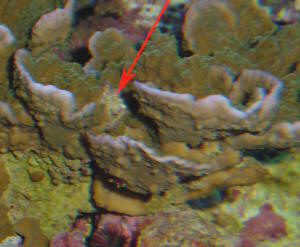
| Resend of diseased Montipora capricornis
close-up 7/2/06 Dear Bob, <Brad> Thank you for
the kind and speedy reply. I am resending the
photographs of this diseased Montipora capricornis separately in
case your server has limits on file size... Here is
photograph #2. Please let me know if you would like a
higher resolution, as I have reduced the file size on
these. Also, I changed the JPEG format from
"progressive scan" to
"baseline-standard". If this doesn't
help, perhaps you could please let me know (one word would
suffice) what other format your computer likes. Thanks again,
Brad in Basalt <A few hundred kilobytes... these are fine
though... pix of the day as a matter... This looks like a
physical injury incident as well to me... Same diagnosis, same
lack of specific treatment. BobF> P.S. Special
thanks to DianaF, N. Sulawesi for the continuous string of
stunning photographs for us all to enjoy. Do you know
if these are taken with an underwater camera in a tank, in the
wild, or if they are simply taken "through the glass"?
<Oh! These are from our more recent sojourn to this large
island of Indonesia (going back a few months hence)... Made with
an (Ikelite) housed (digital SLR Nikon) camera. Have told her of
your note... and "the huntress" is pleased.
BobF> |
|
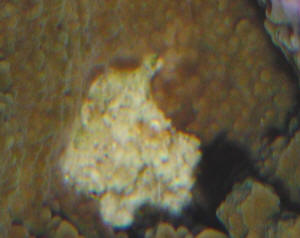
|
|
| Resend of diseased Montipora capricornis
close-up 7/2/06 Dear Bob, <Brad> Thank you for
the kind and speedy reply. I am resending the
photographs of this diseased Montipora capricornis separately in
case your server has limits on file size... Here is
photograph #2. Please let me know if you would like a
higher resolution, as I have reduced the file size on
these. Also, I changed the JPEG format from
"progressive scan" to
"baseline-standard". If this doesn't
help, perhaps you could please let me know (one word would
suffice) what other format your computer likes. Thanks again,
Brad in Basalt <A few hundred kilobytes... these are fine
though... pix of the day as a matter... This looks like a
physical injury incident as well to me... Same diagnosis, same
lack of specific treatment. BobF> P.S. Special
thanks to DianaF, N. Sulawesi for the continuous string of
stunning photographs for us all to enjoy. Do you know
if these are taken with an underwater camera in a tank, in the
wild, or if they are simply taken "through the glass"?
<Oh! These are from our more recent sojourn to this large
island of Indonesia (going back a few months hence)... Made with
an (Ikelite) housed (digital SLR Nikon) camera. Have told her of
your note... and "the huntress" is pleased.
BobF> |
|

|
Bleaching Montipora - 06/14/06 Hi
Crew, <<Hello Mohamed>> A LFS has an orange Monti with
orange polyps but the one side is white as if it is bleaching, like a
patch. The white portion still has the orange
polyps. It is been like that for 3 days. Will
the polyps be dead if it was truly bleaching? <<No, not
necessarily...though the polyps often bleach as well.>> Will
this Monti recover its colour with good lighting? <<Loss of
pigmentation (bleaching) could have been caused by any number of
stressors, with an "excess" of lighting being my first
guess. But yes, it is quite possible this coral can
recover with proper acclimation/care>> Will it be safe to buy
this Monti before it goes to someone else? <<Not
possible/enough info for me to say...tis up to you to decide on this
gamble my friend>> Thanks, Mohamed <<Regards,
EricR>>
Montipora Eating Nudibranch Predator? -
05/26/06 Hello WWM staff, <<Hello Stephen> I recently
noticed a small number (at least what I could see) of Nudibranchs
consuming various species of my Montipora. <<Mmm, very
bad...and their numbers are higher than you realize>> This was
very disappointing as I have gone through a QT for everything, but
obviously something slipped by my inspection. <<Indeed>>
Over the past 3 weeks I have moved most of my Montipora to a frag
tank where I inspect and manually remove the adults and eggs at least
every other day. <<Prolific breeders, I would do this
daily...if you're serious about eradicating the
Nudibranchs>> Finding very few now and found none yesterday!
<<Keep checking...a few weeks quarantine in order here>>
I do however have 2 large colonies of M. digitata that I can not
remove completely as they have encrusted large rocks at their bases.
<<Different species about (Nudibranchs), but my experience with
these critters is they showed a definite preference for the plating
(e.g. - M. capricornis) and encrusting (e.g. - M. danae) Montipora
over the branching varieties>> Just yesterday I noticed 1 Nudi
at the base of one of these colonies (Where there is one, I'm
sure there are more). <<Yes>> After dispatching this Nudi
I inspected as best I could and can not see any more. <<Again,
in my experience, once the food source is removed they tend to
"disappear" quickly>> So having found this in my
display still and not being able to easily remove all of the
Montipora, is there a fish predator for these guys that would make an
appropriate addition to a community reef tank for a 90gal?
<<Not that I'm aware...for sure. Some of the
reef-safe wrasses "may" eat the Nudibranchs, but I have
never witnessed/heard confirmed reports of this. If you
wish to try, a wrasse from the genus Halichoeres might be a good
choice>> I have seen a couple of species or wrasses mention,
but little direct discussion. <<Indeed...I once experienced and
episode with these Nudibranchs...I had wrasses from four different
genera in my tank (including Halichoeres) but could never discern any
of them feeding on the Nudibranchs>> Thank you, Stephen
<<Quite welcome, EricR>>
Chemical Warfare? 4/6/06 I mentioned in my
last email that my SPS started showing signs of stress. Their tips
started dying. I have a doubt about my anemone, do you think that it
can secrete allelopathic substances that can affect the SPS? <I
believe that it is entirely possible, which is why I discourage
mixing corals and anemones in most systems.> I looked up the
archives but I am not sure if this is right or wrong. <I think
that the theory is right.> It has been in the tank for 6 months
now and once in a while, I lose one or two of my SPS for the same
reason, either dying tips or bleaching , but mainly the tips begin to
die. <Could certainly be allelopathic competition, or some lapse
in environmental conditions.> Do you think it is the
anemone? The water chemistry is great, calcium is above 400 and heavy
skimming all the time with Euro-reef skimmer, water changes every 2
weeks !! I am confused and I need your help. Thank you. P.S. It is a
red, long tentacle anemone. Regards, Ramy Ontario, Canada <Well,
Ramy- in the absence of other possibilities (such as environmental
lapses), the only theory that I have is that the anemone could be an
issue, unless you're looking at some type of disease affecting
the coral. My advice is to "specialize", and keep only the
coral or the anemone...Hope this helps. Regards, Scott F.>
Marine Algae Woes 4/6/06 Hi Bob, <No his
young pal Adam J. with you tonight.> Hope all is well. <He
was good last time I chatted with him...though busy (aren't
we all).> I got these red algae, they are all over my reek
tank now. They are like little cotton clusters .I tried manual
removal, black snails but they are out of control now. Is that
something I should be concerned about ??? <Yes.> I realized
that some of my SPS are not doing that great lately. <Astute
observation.> Please see attached photo. Thank you. <Ramy
before I give you advice please use the search engine in the main
site re: Cyanobacteria and nutrient problems.> Ramy, Ontario,
Canada.
<Good luck, Adam J.> |
|
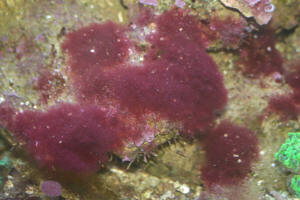
|
| SPS problem!! 4/6/06 Hi
there, I have a problem with my SPS, I started the tank almost a
year ago. I have this algae growing now and dominating the tank (
see attachment ) The growing tips of the SPS die and then the
whole piece dies off afterwards. Any explanation ?? <Not
good... could be pathogenic, but much more likely environmental
in its allowance/occurrence> Do you think this algae is the
reason ??? Thank you. <No... this is secondary, tertiary...
Most likely the root problem/s are environmental.> Regards,
Ramy <Please read here: http://wetwebmedia.com/marine/inverts/index.htm Scroll
down to the Scleractinians tray... read re SPS, Acropora Systems,
Disease... Bob Fenner> |
Algae Over-Growing M. capricornis? - 03/30/06 Hello,
<<Howdy>> I looked for an answer to my question but
couldn't find what I am searching for. I hope you can
help. <<Me too <grin>.>> I have a Montipora
capricornis that is supposed to be orange but it has a layer of green
algae on it. <<?!>> I have tried blowing it off with a
powerhead and gently rubbing it off but have had no
luck. How do you get algae off a piece of SPS
coral? I don't have an algae problem in particular and
it seems that the Montipora is its attachment point of interest.
<<I'm having trouble envisioning this Pete...algae
won't "normally" overgrow the healthy living
tissue. Are you certain this coral is still
alive? And not to be funny but...are you certain this
isn't a "green" Monti? I might be better
able to help if you can provide a sharp close-up photo (.jpg or .bmp
format of no more than a couple hundred KB in size) so I can see what
you're dealing with.>> Thanks in advance for your reply.
Pete <<Regards, EricR>>
SPS problem
!! 3/29/06 Hi Bob, <Ramy> I had my 150
gal running for a year now, housing only SPS and clams. Everything is
fine so far except that one of my favorite Acros started showing the
following : The growing tips started to break and are covered with
algae. <Yikes!> I can see the polyps extending but not as much
as they used to be. I haven't moved this piece from its spot for
more than 5 months, same lighting conditions, great water values ,
nothing else is wrong. So what could have gone wrong ???? <Very
likely "just" the unnatural make-up of aquariums at play
here... Changing the flow (increasing greatly), introducing some
smaller fishes, perhaps switching out some of the live rock... will
steer your system back toward where you want it. Bob Fenner>
Regards, Ramy, Ontario, Canada.
White bugs eating my Acro. - 03/22/06 WWM
Crew, <DG> Thanks for your help with all our fishy needs. This
morning I had a possible revelation on a very big
mystery, Why my Acros were dying (RTN). I
moved a rock in the tank and some sand fell on some of my corals, so
once I placed the rock back I tried to clean my coral of any debris
that might of fallen on them. When I came to the Acro in
question ( a beautiful specimen that once had blue tips) I inverted
the coral to allow gravity to clean off any debris, and I noticed
that some "grains of sand" remained, being the persistent
perfectionist I pretend to be, I placed the specimen in front of the
return to allow the flow to take the sand off. Well upon,
looking closer I realized that the "sand" wasn't sand
at all, they are little white bugs all over the
specimen. Now, I've read on WWM about red bugs that
eat Acros, and of white Nudis that eat Montis, but not white bugs
that eat Acros?! <Come in all colors...> Can somebody lend
advice? Is there any solution other than laying the coral
in bleach and turning it into a very sadistic paperweight? <There
are possible predators to try> I know for a fact that they will
move on to other pieces. The specimen that has them now
was fine and I'm suspecting they came on another specimen that
already had bits of RTN. Your suggestions and advice are
both greatly needed and appreciated. Sincerely yours, David Guzman
Jr. <Do consider stocking some small wrasses... see WWM re other
groups of fishes... Do quarantine future purchases... Bob Fenner>
| Please Help! - dying corals 3/18/06 Hi
Crew, <Greg> I hope you can help me with this
problem. I just returned from a business trip to find
that one of my Acropora corals is dying (see attached picture).
The skeleton is exposed on one entire branched section of the
coral and a brown slime (dead flesh, I assume) is covering the
base of the coral. My makeup water float switch did
stick while I was away and the additional water dropped the
salinity from 1.024 to 1.023 over a 1-day period. Although this
probably caused some minimal stress, I would not have expected
such drastic results. <Happens> I have had this
coral (and others in my tank) for slightly over two years and I
have never experienced any such issues. There have
been no new livestock added to the tank in the past 6-9 months,
so I would be surprised if any type of pathogen would have been
introduced. <Mmm, opportunistic if so... much more likely just
environmental in cause> That said, I did add a dead Montipora
to my refugium approximately two weeks ago. <Ahh,
another source of "stress", pollution> My sister
mailed this coral to me for Christmas. Living in
Florida, she did not realize that it would not survive a winter
mailing to New England. The coral appeared very dead
when it arrived and I was leaving for vacation but, in a last
hope that it might survive, I placed it in my quarantine tank for
6 weeks. Rather than throw it out, I then placed it in
my refugium (I had read of some LPS corals mysteriously
re-growing after several months of appearing dead). I
do not know the origin of this coral but I had assumed that 6
weeks in a QT would have eliminated any risk from introducing it
into my main tank system. Is it possible that
chemicals stored in this Montipora could have affected my
Acroporas? <Yes> My tank is 180g + 100g refugium (6"
DSB, Caulerpa, red Gracilaria) so I had not expected this volume
of water to be largely affected by such an
addition. Possibly other corals are releasing
chemicals that are attacking this Acropora? <Is possible> I
have attached a picture of the entire tank so you can see the
placement of other corals in the tank. Maybe this will
provide a clue? Water stats: Temp=77F, Ammonia=0, Nitrite=0,
Nitrate<5 ppm, pH=8.1, Alk=4 meq/l, PO4<0.5 ppm, Ca=400
ppm, Mg=1,500 ppm. These readings are mostly typical
of water parameters for the 3+ years since I began the aquarium.
Temperature is 1-2 degrees cooler than it runs in the summer and
pH is actually slightly higher than past (I have been dosing
baking soda and washing powder [NaCO3] for several months in an
attempt to increase the pH). <Mmm, I would be using other
means... is a calcium reactor in your future?> About 4 weeks
ago the Montiporas in my main tank began to bleach as well. As
you can see, all of the other corals, inverts, fish, continued to
appear healthy so I was not overly worried. I assumed this was
only a temporary condition. Around the same time my
coralline algae began to turn white and flake off as
well. Since my Ca and alk appear to be within
"normal" ranges, I could not explain the loss of
coralline algae either. I apologize for the long email but I am
hoping something in this information might help to explain why
this coral is dying. One more recent change: just
before I left for my trip, all of the Astrea snails in my tank
began releasing eggs / sperm into the water. There
appeared to be tiny "smoke trails" coming from about
100 snails. <Yes... another (perhaps) indication of a stressed
environment> I had assumed that this would have provided food
for the corals but maybe this could be a clue as well. <Of a
certainty> I am at a total loss trying to determine why this
is happening and how to correct the problem. I will be
out of the country for the next week so I am terrified what I
might find when I return if I do not address this now. Please
help. I greatly appreciate any advice you can provide!
--Greg <Mmm, "when, where in doubt, change water"...
I would institute some substantial water changes, boost your
iodine/ate supplementation weekly, consider adding a vitamin
supplement directly to the water (like Selcon, Microvit...). I
would not "frag" the Staghorns just yet... Do consider
switching even to a "two part" mineral/alkalinity
approach... Bob Fenner> |
|
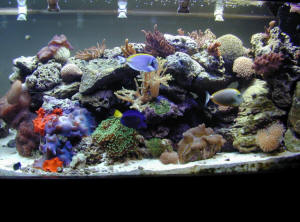 
Today's faq... re baking soda... Please Help! - dying
corals- 03/18/2006 Appended is the faq in question. Being that
noticed using baking soda and "washing powder" (borate?)
Since, corals don't use borate alkalinity, and that being
alkalinity reading of 4 meq/l thinking that lack of
carbonate alkalinity being major culprit since the things that seem
to have trouble require carbonate alkalinity? <Yes>
There are test kits specifically for carbonate alk. Also this
explanation, drives the point needing to major water change, use 2
part dosing or calcium reactor. Ps, I love my calcium reactor for its
benefit of stabilizing ph, alk, magnesium, &
calcium. Granted the ph stability is a byproduct of
keeping the alkalinity high. <Mmm, yes! Am often pressed (by
myself) to "come up with" a/the more appropriate
response... Do you have time, interest to aid our efforts?
BobF>
Re: Please Help! - dying corals - 03/18/2006 Bob,
<Greg> Thank you for your response. After examining
the Acropora again last night, it appeared that the tissue loss had
increased since I emailed you. So I fragged the one
remaining small branch portion that appeared to have full flesh and
polyps intact. I dipped the remaining coral and the frag
in a Lugol's + tank water solution, placed the frag back in my
main tank and placed the remaining coral in my
refugium. When I checked this morning, I found the
original coral had lost the remainder of its tissue and only a white
skeleton remained. The flesh was floating in the refugium
and the odor was very noticeable to say the least. At
least the frag appears to be doing better. It has all
flesh and full polyp extension. I performed a 32 gallon water change
and added activated carbon tonight. I also discovered that
the light, which was above several of the corals (including the
decaying Acropora) has loosened from its swivel and was angled
slightly differently than normal. Again, would not expect
this to cause significant problems by itself but could be one of many
factors that came together at the wrong time. <Perhaps so> I
repaired this light mounting as well. Yes, I have the materials to
build a Ca reactor. As soon as I can get a few days at
home I hope to complete this project. I typically dose
9-10 drops of Lugol's each week. Tonight I added 4
teaspoons of "Purple Up" instead, since it is supposed to
contain 10 micron aragonite, Ca and iodine / iodide. Hopefully these
steps have helped. <Believe so> I guess all I can do now is
wait. I only wish I were not going to be away for a week
at this time. I really appreciate your input -- thank you! --Greg
<Thank you for this update... Do take a read at today's Daily
FAQs, as someone has written in re your prev. corr. Cheers, Bob
Fenner>
|
|
|

